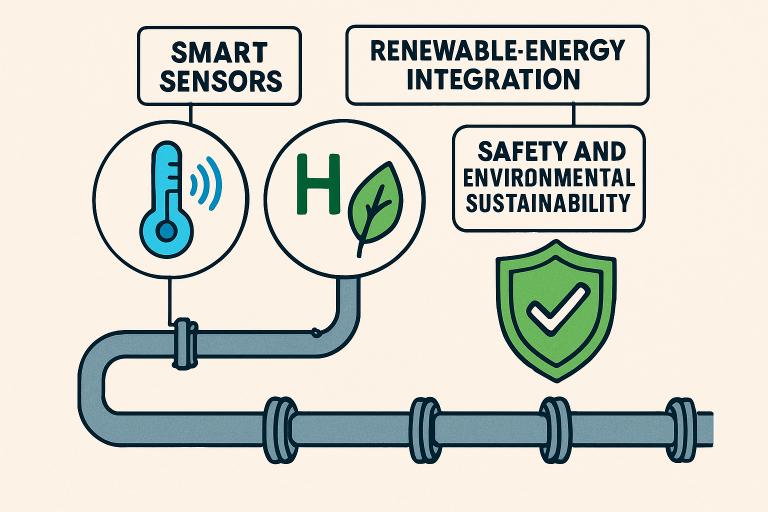Pipelines are crucial in transporting resources that fuel industries, households, and communities. As infrastructure expands, the focus has shifted from simply meeting demand to ensuring safety, efficiency, and sustainability. Modern pipeline technologies are designed to move materials effectively and minimize risks associated with leaks, corrosion, or environmental damage. By incorporating innovative approaches and advanced monitoring systems, engineers and policymakers can develop infrastructure that supports long-term economic growth while protecting public health and the environment.
Integrating modern pipeline integrity tools helps guarantee that infrastructure meets regulatory compliance and community expectations for environmental stewardship. These technologies provide valuable insights into the condition of pipelines, allowing for early detection of potential issues before they escalate. With continuous monitoring and data-driven assessments, stakeholders can implement timely maintenance strategies, reduce environmental risks, and extend the lifespan of essential infrastructure. This proactive strategy guarantees that pipelines stay dependable, robust, and in line with larger sustainability objectives.

Table of Contents
Advanced Materials and Coatings
Conventional steel pipelines have long been the industry standard, but they are susceptible to corrosion and environmental damage over time. To counter this, modern pipelines use advanced composite materials and coatings that drastically improve durability. Composite pipes, often constructed with a mix of polymers and fiber reinforcements, provide stronger resistance to cracking, weathering, and chemical attack. Nanotechnology-enabled coatings offer a new level of protection, forming barriers that repel damaging elements and minimize maintenance intervals. These solutions not only prolong the lifespan of pipelines but also lower the frequency of unexpected outages, aiding operators in achieving sustainability goals and cutting long-term expenses.
Smart Monitoring Systems
Smart monitoring systems represent a revolution in pipeline safety and maintenance. Networked fiber-optic sensors, paired with advanced software, constantly analyze changes in temperature, pressure, and acoustics throughout the pipeline’s length. These technologies detect leaks, ruptures, or unauthorized activity in real time. Instead of relying solely on periodic inspections, operators receive instant alerts, allowing for quick shutdowns and repairs. This enhances operational safety, slashes downtime, and prevents environmental contamination.
Integration of Renewable Energy
The shift towards green energy has catalyzed the evolution of pipelines to transport renewable gases such as hydrogen and biogas. Retrofitting and constructing new pipelines to handle these less carbon-intensive fuels is critical to meeting international climate goals. Operators are employing specialized materials and layouts to safely move hydrogen, which is more prone to leakage than natural gas. This integration enables long-distance delivery of clean energy and supports the development of resilient, flexible infrastructure that reduces dependence on fossil fuels without a complete overhaul of existing networks.
Automation in Pipeline Construction
Automation technology is transforming pipeline construction and upkeep. Robotics and automated machinery now handle hazardous, repetitive, or precision-demanding tasks that once posed significant risks to workers. These systems can install pipelines in remote or challenging terrain with greater accuracy and at lower cost. By minimizing manual intervention, companies see shortened project timelines, enhanced worker safety, and more consistent quality across installations and repairs. This comprehensive use of automation is establishing a blueprint for future pipeline builds worldwide.
Artificial Intelligence in Risk Assessment
Artificial Intelligence (AI) empowers energy companies to move from reactive to predictive maintenance strategies. AI-driven analytics sift through massive datasets from sensors, weather sources, and historical incidents to forecast potential failure points. These systems automatically prioritize risks and suggest preventive measures, allowing teams to intervene before a leak or rupture occurs.
Environmental Compliance and Sustainability
As environmental regulations become more stringent, pipeline operators are adopting eco-friendly innovations. These include automated spill containment, advanced leak detection, and biodegradable, non-toxic coatings that reduce environmental impact. Many now use real-time reporting and response systems to ensure quick compliance with standards, enabling faster incident recovery. These enhancements protect natural resources and also boost public trust and regulatory cooperation.
Decentralized Gas Distribution Systems
The emergence of decentralized gas networks, or micro-grids, is reshaping energy supply frameworks. These localized systems offer increased resilience against interruptions, flexible delivery to diverse consumers, and efficient integration of locally produced biogas or hydrogen. By reducing dependence on massive centralized networks, decentralized systems enhance energy security and pave the way for adaptable, community-based infrastructure solutions worldwide.
Conclusion
Technological innovations are transforming the potential of pipeline infrastructure. Enhanced safety monitoring, sophisticated materials, seamless renewable integration, and predictive analytics are transforming pipelines from static assets into dynamic, intelligent networks. As demands for environmental stewardship and operational transparency grow, adopting these technologies puts the pipeline sector at the forefront of building safer and more sustainable global infrastructure systems.


